Observations:
I observed a bunch of random people and purposely did not get their names or tell them I was observing them.
2:20 to 2:30, McCosh 50, before ECO 100 lecture on Thursday, 2/21 (about 300-400 students)
- The professor, Harvey Rosen, was there before 2:20, and he spent his 10+ minutes drawing graphs and figures that he would need for lecture on the blackboard, as well as setting up his PowerPoint slides.
- A large number of students (I would approximate about 200) were doing nothing other than chatting with friends or sitting in silence.
- Lots of students would walk into the giant lecture hall and spend some time just looking for their friends or walking around to find someone they knew. This caused a decent amount of traffic in such a large class.
- One student was coding on his laptop during the 10 minutes.
- One student mentioned: “I wish I could be doing my math homework right now, but my textbook is back in my room.”
- Lots of students pulled out their phone to catch up on texts, emails, and Facebook.
- A surprisingly small amount of people (I could only count about 20 on the main floor of McCosh 50) pulled out their laptops. I would guess that laptops are not allowed during lecture, or at least not ideal for taking notes because of the large quantities of graphs in that class.
- I left immediately when the lecture started.
1:22 to 1:30, Woolworth 105, before MUS 103 precept on Tuesday, 2/26 (about 15 students)
- The preceptor had a class in the same room beforehand, so there were some students who stayed behind to ask questions, which took up about 5 minutes of the preceptor’s time.
- The preceptor spent his remaining time writing a few things on the blackboard that he would need later on in class.
- One student walked in, thinking he was in the right precept. He looked around and quickly realized he was an hour early for his actual precept, and he scurried out, looking slightly embarrassed.
- The preceptor started taking attendance at 1:31. He does it the old-fashioned style by just calling out names (since there are only about 15 people). However, there were 4 students that walked in while he was taking attendance, so whenever one of them walked in, he had to check if he had marked them as absent and then fix it if he had. It seemed highly inefficient.
- A good amount of students pulled out their phone during the waiting time.
2:54 to 3:00 in CS 104, before HCI lecture on Tuesday, 2/26 (about 60 students)
- Dr. Vertesi (guest lecturer) spent pretty much all of those 6 minutes fiddling with the projector, the lights, and other technology in the room. A student helped her and seemed to get it working, and the lecture didn’t start until 3:03 because of technical difficulties.
- A good amount of students were eating/drinking things. I observed a lot of coffee/tea, a banana, a churro, and a granola bar.
- The auditorium is terrible for seating: people seem to naturally like sitting towards the edges of each row, which makes it really difficult for people to get to open seats because of how narrow the rows are. I observed about a half-dozen students even climbing over seats just so they wouldn’t have to squeeze through a bunch of people. This problem is made worse by the fact that students want to sit next to their friends.
Brainstorming:
I collaborated with Gabriel Chen.
- Hand warmer mats on desks, activated when they sense force.
- Attendance (done quickly and automatically, perhaps by proxing in) at entrance of lecture hall/precepts for classes that take attendance.
- Attendance (done quickly and automatically, perhaps by proxing out) at exit of lecture hall/precepts to discourage people from leaving early.
- An app that automates taking attendance by using GPS: you “check-in” at the beginning of class and “check-out” at the end of class so that the professor knows that you were both on-time and stayed for the entire lecture.
- Sensor on every seat that connects to an app that tells you where your friends are and whether the seats are occupied.
- An app that has a general map of the classroom that you can use to “reserve” seats for friends; this is useful because it can be awkward telling other students that seats are “taken” when they aren’t actually “taken”.
- An app that shows you the outlet locations in lecture halls and whether they’re currently being used or not.
- An app that lets bikers press the crosswalk button automatically (so that they don’t have to get off the bike) by using proximity detection techniques.
- An app that electrocutes you (really gently…) when you start dozing off in lecture or even before the lecture starts: detects “nodding off” by using an accelerometer on your head.
- A live chat with OIT that is accessible on all computers built into lecture halls (for example, in CS 104, both Professor Fiebrink and Dr. Vertesi have had issues with the technology in that room even though they are obviously very capable with technology).
- An app that releases Febreze or some other subtle odor cancelling substance when it detects that you are farting or burping in a lecture hall.
- A device or system that lets professors see what they’re writing on the board from the back of the room perspective, so they can determine how large to write on a blackboard.
- A portable device that can project things clearly onto a blackboard: some professors spend the 10 minutes before class writing material or drawing graphs that they will use later on during the lecture, and they need to use the blackboard because they have lecture slides to show on the projector screen.
- A device built into the top of a blackboard that releases a torrent of water so that professors can erase the board from a previous class with a gesture or touch of a button; there is also a drain at the bottom, and a dryer for the board.
- A system that allows for delivery from restaurants directly to your lecture hall so that they’ll be there with your food by the time you get there.
- A device that automatically scrolls your phone if your eyes are at the top or bottom of the screen; students are often carrying lots of things and don’t have a free hand to actually use their phone.
- Phone keyboards that sense where your hand is positioned so that when you want to type with one hand, the keyboard is condensed onto one side of the screen; this is another problem for students who are carrying a lot of things to class.
Ideas chosen for prototyping:
- An app that automates taking attendance by using GPS: you “check-in” at the beginning of class and “check-out” at the end of class so that the professor knows that you were both on-time and stayed for the entire lecture. For classes that take attendance, I have never seen a good system for doing so. Some classes pass around a sheet, which often takes a really long time and inevitably skips over some people because students decide to pass the sheet in whatever direction is most convenient for them. Some students also come just to sign-in, and then leave. This app would automate the attendance process and also help discourage students from leaving lecture.
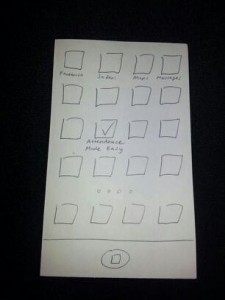
A typical iPhone screen. Attendance Made Easy is the name of my app.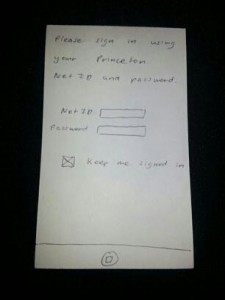
Users need to sign in with their Princeton NetID and password to verify their identity. They can stay signed in to make it easier to use day-to-day.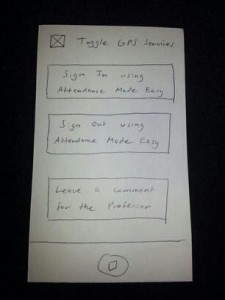
The home screen for the app itself. There is easy-access to turn GPS services on/off since GPS is required for the app to work properly. There are three main buttons for signing in, signing out, and leaving a comment for the professor.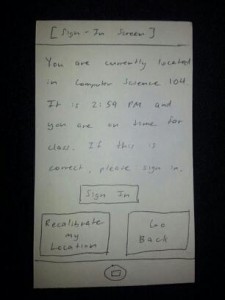
The sign-in screen. Based on GPS, it tells you what building you’re located in so that you know you’re signing into the right class. There’s an option to recalibrate if the GPS reading is wrong.
The sign-out screen. Based on GPS, it tells you what building you’re located in so that you know you’re signing out of the right class. There’s an option to recalibrate if the GPS reading is wrong.
The comment screen. It tells you what class you’re in and the professor that will be receiving your comment. Basically, I envisioned using this option for any extenuating circumstances if a student was late or needed to leave early but had a legitimate excuse.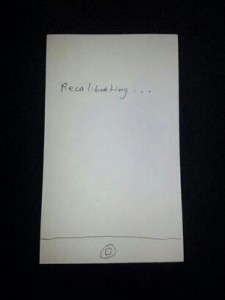
The waiting screen if you click recalibrate. Basically the GPS would just refresh your location.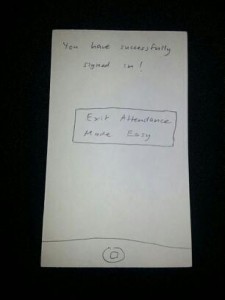
The screen you see after successfully signing in. There’s just a single button to exit the app.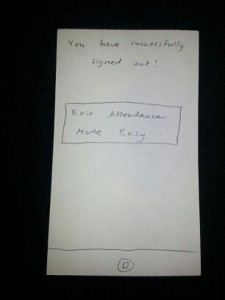
The screen you see after successfully signing out. There’s just a single button to exit the app. - Phone keyboards that sense where your hand is positioned so that when you want to type with one hand, the keyboard is condensed onto one side of the screen; this is another problem for students who are carrying a lot of things to class.This seems like a feature on phones that should already be implemented. As phones have been getting bigger and bigger, it’s become increasingly harder to type with just one hand (especially for people like myself with small hands).
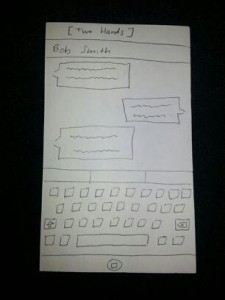
This is what the normal phone keyboard looks like when it senses two hands using the phone (the default keyboard, no different from a phone in its normal state).
When it senses that you take your left hand off, the keyboard becomes condensed on the right side so that all keys are easy to reach with just your right hand. For users who have big hands and have no need for this feature, they can press a button to revert back to the default keyboard.
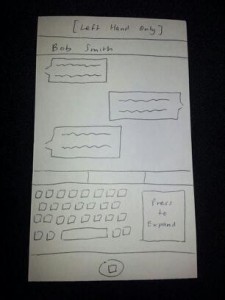
When it senses that you take your right hand off, the keyboard becomes condensed on the left side so that all keys are easy to reach with just your left hand. For users who have big hands and have no need for this feature, they can press a button to revert back to the default keyboard.
User Testing:
Osman Khwaja, a junior in the COS department, tested the attendance app.
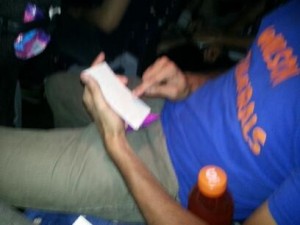
- He said there was too much text. For the sign-in and sign-out screens, he didn’t want to bother reading all of that. Just have a couple words that list the location, time, etc.
- He never used the comment button. He didn’t really know what it was for, and wasn’t really sure it was necessary even when I explained what I envisioned it being used for (a student with an excuse for being late or leaving early).
- He said that the app would be useful overall and make things easier.
Ross Smith, a sophomore in the ECO department, tested the attendance app.
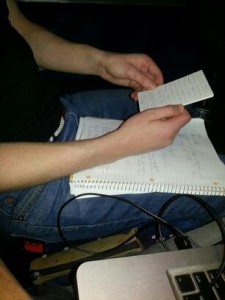
- He said he would never use the comment button because there are already easy ways to interact and communicate with professors. Afterwards, I told him I envisioned it being used for students who had an excuse for being late or leaving early, and he said that made more sense. He suggested just renaming it to an “Excuse” button.
- He said it’s obviously not a viable system unless everybody has a smartphone.
- He didn’t really understand how it worked when he was first going through the home screen and sign-in screen. When I explained that it knew what classroom you were in through GPS, he immediately understood the entire app a lot better.
- Overall, he thought it would be a very streamlined way for professors to take attendance and make sure that students stay for the entire class.
Stephen Wang, a junior in the ORF department, tested the attendance app.

- He actually knew what the comment button was for. He said he would use it to explain to the professor why he was late. He said it would obviously not help for telling the professor why you’re absent since you can only use it if you’re in the right classroom.
- He also mentioned that it requires all students to have a smartphone.
- He said that it would motivate him to go to class more often, which is a great side effect.
- He said it was easy-to-use and a really good idea.
Insights:
- Each button needs to have a clear function and a simple yet descriptive name. I created the comment button thinking students would want to leave comments to professors if they had any relevant issues with their attendance that day. However, when users saw the word “comment,” many of them just assumed it meant general feedback for the professor about the course, and they were confused about the functionality or just didn’t bother using it. I should rename the button to say, “Leave the professor an excuse.”
- People are lazy. They don’t want to read a lot of text. The app should be as streamlined as possible since it’s something that students would potentially use multiple times a day.
- It’s unrealistic to implement this for actual attendance since it requires all students to have a smartphone. I kind of realized this from the beginning, but still wanted to prototype it and get feedback.
- There’s potential. My testers all said it would be useful, and that there’s really no good way for professors to take attendance right now without being inefficient or annoying in some way.
